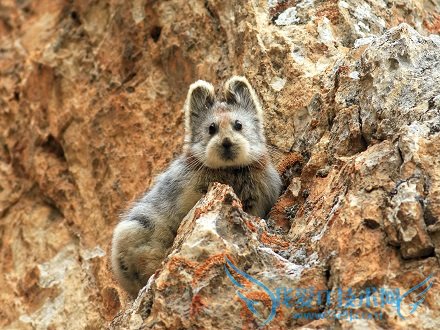��ӭ������52ijӢ��������������С��Ϊ�������Ӣ��֪ʶ�ǣ�����̩����������20���������ɽ������������ϸ�ķ�����
��̩����������20���������ɽ

You could call it one of the world's longest games of hide and seek. �������ʷ�Ϻ�ʱ����Բ��ˡ�
For more than 20 years, the Ili pika (Ochotona iliensis), a type of tiny, mountain-dwelling mammal with a teddy bear face, had eluded scientists in the Tianshan Mountains (map) of northwestern China.�������ã�����СС�ģ�����һ�����ȵ�̩�������ĸ�ɽ�����鶯���Ѿ���פ�����й�������ɽɽ���Ŀ�ѧ�ҵ�������ʧ��20�����ˡ�
People have seen the furry critter only a handful of times since it was discovered by accident in 1983. In fact, people have spotted only 29 live individuals, and little is known about the animal's ecology and behavior.�Դ�1983���������ñ����ⷢ��֮�����Ǽ�������ë����С����Ĵ�����ֱ��ָ������ʵ���ϣ�����ֻ������29ֻ�������ã���˶������ǵ�����ϰ�Ժ��������֪֮���١�
Then, in summer 2014, researchers rediscovered the pika. ���ǣ������������κ�Ԥ�ģ���2014����������������ٴγ����ˡ�
Weidong Li, the species' original discoverer and a scientist at the Xinjiang Institute for Ecology and Geography, had gathered a group of volunteers in the Tianshan Mountains for some pika searching. At noon one day, as they were setting up camera traps, the team spotted their prize.���������������������ֵ��й���ѧԺ�½���̬������о�������ά���о�Ա��Ϊ����Ѱ��������ɽ������֯��һ֧־Ը�߶��顣һ�����磬���������ú��������ͻ����������֡�
"They found it hiding behind a rock, and they realized they had found the pika. They were very excited," said Tatsuya Shin, a naturalist in China who works with the pika's discoverers. �����Ƿ����и�С��������ʯͷ���棬��ϸһ����һֻ���ã���Ҷ����˻��ˡ������й��Ŷ�һ������һλ��Ȼѧ��˵��
The animal was about 8 inches (20 centimeters) long, with large ears and several small brown spots in its gray fur. Li wasn't familiar with the species, nor were nearby herdsmen. Li caught a specimen and sent it to a scientist at the Chinese Academy of Sciences, who said he believed the pika was a new species. ���ֶ��ﳤ��Լ20���ף����Ķ��䣬��ɫ��Ƥë�������ǵ���ɫ�ߵ㡣��ά��û�����������֣����ص���Ҳû������������ά����ץ��һֻ���ɱ걾�͵����п�Ժ��һλר�����У�ר����ϸ�о�֮����Ϊ��ֻ��������һ��ȫ�µ����֡�
Like other species of pika found in North America, the Ili pika lives at high elevations��between 9,200 and 13,450 feet (2,800 to 4,100 meters)��and subsists mainly on grasses, herbs, and other mountain plants.�������ڱ����������ֵ�����һ�����������������ں�����2800����4100��֮��ĸߺ��εش������滷����Ҫ�����ݵغ�һЩ��ɽֲ����Χ��
Like other high-dwelling creatures, the pika is sensitive to changes in its environment. A 1990s estimate put its population at about 2,000 individuals, and it's believed to be decreasing in number, according to the International Union for Conservation of Nature.ͬ�����ߵ�����һ�������ö������滷���ĸı�ʮ�����У�������90�����һ�����������ǵ���Ⱥ��������ֻ��2000ֻ���ң����Ҹ��ݹ�����Ȼ�������˵���Ϣ����һ�������ڲ��ϼ��١�
Grazing pressure from livestock and air pollution have likely contributed to the decline in the Ili pika, which IUCN lists as vulnerable to extinction. China considers the species endangered.������ɵ���̬ѹ������Ϣ�صļ��ٺͿ�����Ⱦ�ȶ��ǿ������������Ⱥ�������ٵ�ԭ������Ȼ���������Ѿ������ù���������Ķ��������С��й�Ҳ�����û�Ϊ�˱�Σ���֡�
Even so, there are no concerted efforts under way to help the Ili pika. Li said he hopes to change that, and use the rediscovery of the animal to create conservation areas for the species. �������������Ȼȱ���ܹ������������õ���Ч��ʩ����ά��˵��ϣ�����õ��ٴγ����ܹ��ı���״��ͨ��������صı������������ֶ���������ȥ��
How could anyone turn down a face like that?����һ������ȵ�����˭�����������ʧ������������أ�
- �����б����������۽������ѱ�����˿���������������վͬ����۵��֤ʵ��������
-
